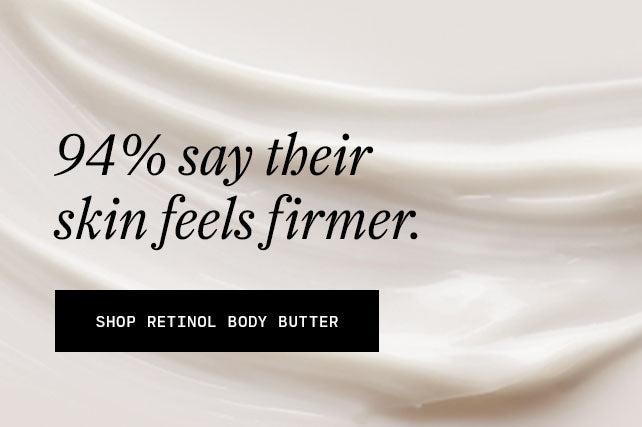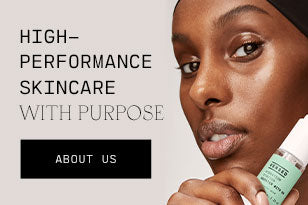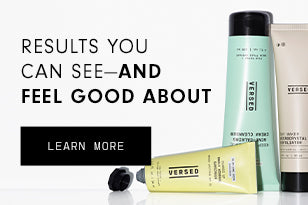
9 ‘Intimidating’ Ingredients You Shouldn’t Be Afraid Of
Gone are the years that we solely relied on magazines—and maybe our big sister—when it came to beauty advice. Thanks to smartphones, we have the answer to nearly any question (skin-related or not) at our disposal 24/7. Sometimes it comes in handy (like our ability to text the Skin Hotline) and sometimes a catchy headline at the top of our feed is all it takes for us to question the products we’re using and the safety of the ingredients within them. Whispered rumors and trending buzzwords have confused even the most savvy shoppers for years, but a simple peek at an ingredient’s meaning and where it’s sourced from is enough to settle the debate of what’s okay to use versus what’s not. To help clear up any confusion and put cautious minds at ease, we’ve pulled a few common scary-sounding skincare ingredients that you may find yourself avoiding, but are perfectly safe (and even quite beneficial).
As always, visit any Versed product page, tap on the Ingredients tab, and hover over any unfamiliar ingredient for its easy-to-understand definition (our Ingredient Glossary is also a handy resource). If you’re unsure about whether an ingredient works for you or if you’re pregnant or breastfeeding, always refer to your doctor.
Phenoxyethanol | feen·oxy·ethanol
Naturally found in green tea, this preservative can be synthetically made and added to products to preserve their potency and prevent the formula from spoiling. It’s been cropping up even more recently as a safe alternative to parabens—in fact, nearly ¼ of cosmetics contain it. Unless you have a specific allergy to phenoxyethanol or have been told by a doctor to avoid it, it’s a perfectly safe additive.
Limonene | lim·o·nene
Taken from the rind of citrus fruits, limonene is a sweet-smelling oil. It’s often found in skincare at high levels as an alternative to artificial fragrance or at low levels as a solvent, which is how we use it. Solvents dissolve or break down other compounds, like water, oil, alcohol, and more. In doing so it functions as a penetration enhancer, and in the case of limonene, primarily for oils. You’ll usually see towards the end of an ingredient if it’s being used, safely, as a solvent. At high levels it can be irritating to sensitive skin, much like essential oils can irritate skin if used improperly.
Zinc Oxide | zinc ox·ide
We know this one sounds intimidating, but many sunscreens contain zinc oxide. As you may remember from chemistry class, zinc is a mineral. Zinc oxide physically absorbs and scatters UVA and UVB rays (meaning it's qualified as broad-spectrum) to protect your skin from harm. It’s not only proven to be effective, but it’s also considered the safest SPF active available for us and the environment. You’ll find its non-nano version (non-nano refers to particle size; in simplistic terms, ‘nano’ is really small while non-nano is larger and offers better protection) in our Guards Up SPF.
Ethylhexylglycerin | eth·yl·hex·yl·gly·sa·rin
This (very difficult to pronounce) ingredient is another preservative that’s often found in paraben-free products. But it also has some powerful skin conditioning properties. Recognize the term ‘glycerin’ at the end? Many moisturizers, creams, and conditioners contain glycerin because it’s a humectant (a.k.a. able to pull moisture from the air and keep skin’s barrier hydrated and smooth). At low concentrations, such as in skincare, ethylhexylglycerin is a non-irritating, safe ingredient.
Tocopheryl | toh·kof·uh·rawl
This scary-sounding ingredient is just….vitamin E. Whether you see the term ‘acetate’ added to the end of it (which simply means it was synthetically made in a lab), tocopheryl is the scientific term for this very common antioxidant that strengthens and smooths, which is why you’ll see it on the ingredient list for Sunday Morning.
Similarly to the term ‘acid’, alcohol doesn’t sound like something we’d want to put on our face. But like many other chemicals, there are types that can fall into the ‘good’ and ‘not-so-good’ category (technically, retinol is an alcohol). Stearyl is one of the beneficial alcohols that’s derived from fatty acids and, when found in skincare, keeps complexions nourished, hydrated, and plump.
Xanthan Gum | zan·than gum
You’ve probably seen this on ingredient lists for many things found in your fridge, such as almond milk and shortening. It’s an additive that’s used as an emulsifier—an ingredient that allows unlike chemicals, like oil and water, to combine. It’s safe and, when added to skincare, may even provide some moisturizing fringe benefits.
1, 2 Hexanediol | hex·an·dye·ole
This synthetic solvent helps dissolve other ingredients to improve their benefits and texture. The numbers in front of it? That’s just to denote the structure of the molecule. Hexanediol is non-sensitizing, but some rare cases have reported irritation. Talk to your primary care physician if you think this may be a concern for you.
Squalane | skwa·lane
Squalane is a plant-derived ingredient that restores moisture levels and keeps skin smooth and supple. Sounds good, right? But here’s where it gets confusing: Squalene is a part of skin’s natural moisture, but when you see it added to ingredient lists, it’s probably derived from things like shark liver. Keep an eye out for those tricky spelling changes, but know that squalane is a safe choice for you and the environment. In fact, it’s what makes our Rich Moisture Cream so skin-softening.
Propanediol | pro·pane·dye·ole
Propanediol is often used as an alternative to the paraben propylene glycol. It’s used in products like serums and masks to enhance the skin's ability to absorb the formula inside. This ingredient is sometimes controversial because it can be sourced from petroleum, but Versed products only use propanediol derived from cornstarch and sugar.
What about other scary-sounding terms like AHAs and dermaplaning? Read why you shouldn’t be afraid of these common skincare rituals.






